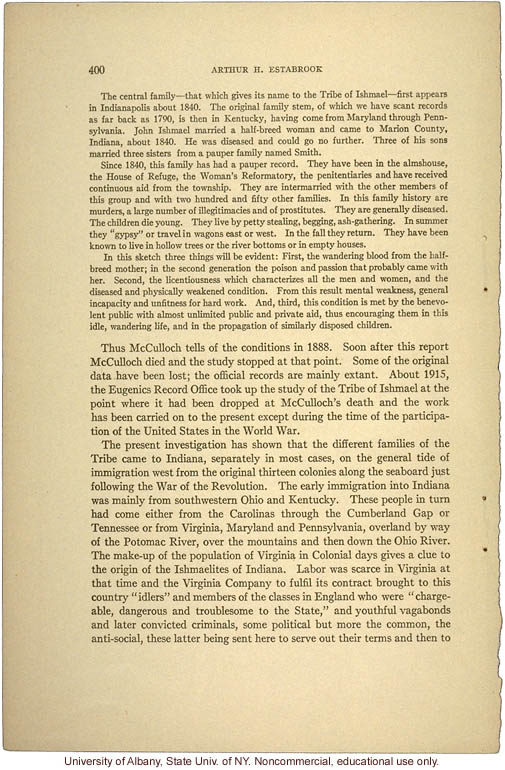400 Arthur H. Estabrook
[extract]The central family - that which gives its name to the Tribe of Ishmael - first appears in Indianapolis about 1840. The original family stem, of which we have scant records as far back as 1790, is then in Kentucky, having come from Maryland through Pennsylvania. John Ishmael married a half-breed woman and came to Marion County, Indiana, about 1840. He was diseased and could go no further. Three of his sons married three sisters from a pauper family named Smith.
Since 1840, this family has had a pauper record. They have been in the almshouse, the House of Refuge, the Woman's Reformatory, the penitentiaries and have received continuous aid from the township. They are intermarried with the other members of this group and with two hundred and fifty other families. In this family history are murders, a large number of illegitimacies and of prostitutes. They are generally diseased. The children die young. They live by petty stealing, begging, and ash-gathering. They have been known to live in hollow trees or the river bottoms or in empty houses.
In this sketch three things will be evident: First, the wandering blood from the half-breed mother; in the second generation the poison and passion that probably came with her. Second, the licentiousness which characterizes all the men and women, and the diseased and physically weakened condition. From this result mental weakness, general incapacity and unfitness for hard work. And, third, this condition is met by the benevolent public and private aid, thus encouraging them in this idle, wandering life, and in the propagation of similarly disposed children.[end extract]
Thus McCulloch tells of the conditions in 1888. Soon after this report McCulloch died and the study stopped at that point. Some of the original data have been lost; the official records are mainly extant. About 1915, the Eugenics Record Office took up the study of the tribe of Ishmael at the point where it had been dropped at McCulloch's death and the work has been carried on to the present except during the time of the participation of the United States in the World War.
The present investigation has shown that the different families of the Tribe came to Indiana, separately in most cases, on the general tide of immigration west from the original thirteen colonies along the seaboard just following the War of the Revolution. The early immigration into Indiana was mainly from southwestern Ohio and Kentucky. These people in turn had come either from the Carolinas through the Cumberland Gap or Tennessee or from Virginia, Maryland and Pennsylvania, overland by way of the Potomac River, over the mountains and then down the Ohio River. The make-up of the population of Virginia in Colonial days gives a clue to the origin of the Ishmaelites of Indiana. Labor was scarce in Virginia at that time and the Virginia Company to fulfill its contract brought to this country "idlers" and members of the classes in England who were "chargeable, dangerous and troublesome to the State," and youthful vagabonds and later convicted criminals, some political but more the common, the anti-social, these latter being sent here to serve out their terms and then to
[end]


